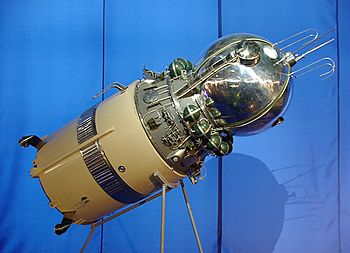Vostok 1 facts for kids

Model of the Vostok spacecraft
|
|
| Operator | Soviet space program |
|---|---|
| Harvard designation | 1961 Mu 1 |
| Mission duration | 1 hour, 48 minutes |
| Orbits completed | 1 |
| Spacecraft properties | |
| Spacecraft | Vostok-3KA No.3 |
| Manufacturer | Experimental Design Bureau OKB-1 |
| Launch mass | 4,725 kg (10,417 lb) |
| Landing mass | 2,400 kg (5,290 lb) |
| Dimensions | 2.30 m (7 ft 6.5 in) diameter |
| Crew | |
| Crew size | 1 |
| Members | Yuri Gagarin |
| Callsign | Кедр (Kedr – Siberian pine) |
| Start of mission | |
| Launch date | April 12, 1961, 06:07 UTC |
| Rocket | Vostok-K 8K72K |
| Launch site | Baikonur 1/5 45°55′13″N 63°20′32″E / 45.920278°N 63.342222°E |
| End of mission | |
| Landing date | April 12, 1961, 07:55 UTC |
| Landing site | 51°16′14″N 45°59′50″E / 51.270682°N 45.99727°E |
| Orbital parameters | |
| Reference system | Geocentric |
| Regime | Low Earth |
| Perigee | 169 km (91 nmi) |
| Apogee | 327 km (177 nmi) |
| Inclination | 64.95 degrees |
| Period | 89.1 minutes |
| Epoch | April 12, 1961 |
 Yuri Gagarin in Sweden Vostok programme
Manned flights |
|
Vostok 1 (Russian: Восто́к, meaning East 1) was a very important space mission. It was the first time a human traveled into outer space. The mission used a special spacecraft called Vostok 3KA. It launched on April 12, 1961.
The person who flew on Vostok 1 was Yuri Gagarin. He was a cosmonaut (a Russian astronaut) from the Soviet Union. This flight was the first time anyone had ever reached space and orbited Earth. The journey lasted 1 hour and 48 minutes and completed one full orbit around our planet. The Soviet space program launched Vostok 1. It was built by famous Soviet rocket scientists Sergey Korolyov and Kerim Kerimov.
Contents
The Vostok Spacecraft
The Vostok spacecraft was designed for one person. It weighed about 4.73 metric tons (about 10,428 pounds). It was 4.4 meters (about 14.4 feet) long and 2.43 meters (about 8 feet) wide. The cosmonaut sat inside a round part of the spacecraft.
Inside the Capsule
Yuri Gagarin sat on a special seat. This seat was also an ejection seat. This meant he could be launched out of the spacecraft in an emergency. During the flight, Gagarin was mostly a passenger. He had controls only for emergencies. The spacecraft also had food, a radio, and a round window.
Landing Back on Earth
After orbiting Earth, the spacecraft began its journey back down. Gagarin ejected from the spacecraft while it was still high up. He then landed safely by parachute. This was a common way for early cosmonauts to return to Earth.
Historic Vostok Missions
Vostok 1 was the first of six manned Vostok flights. These missions helped the Soviet Union learn a lot about space travel. The last flight, Vostok 6, carried Valentina Tereshkova. She became the first woman to go into space on June 16, 1963.
Images for kids
See also
 In Spanish: Vostok 1 para niños
In Spanish: Vostok 1 para niños







